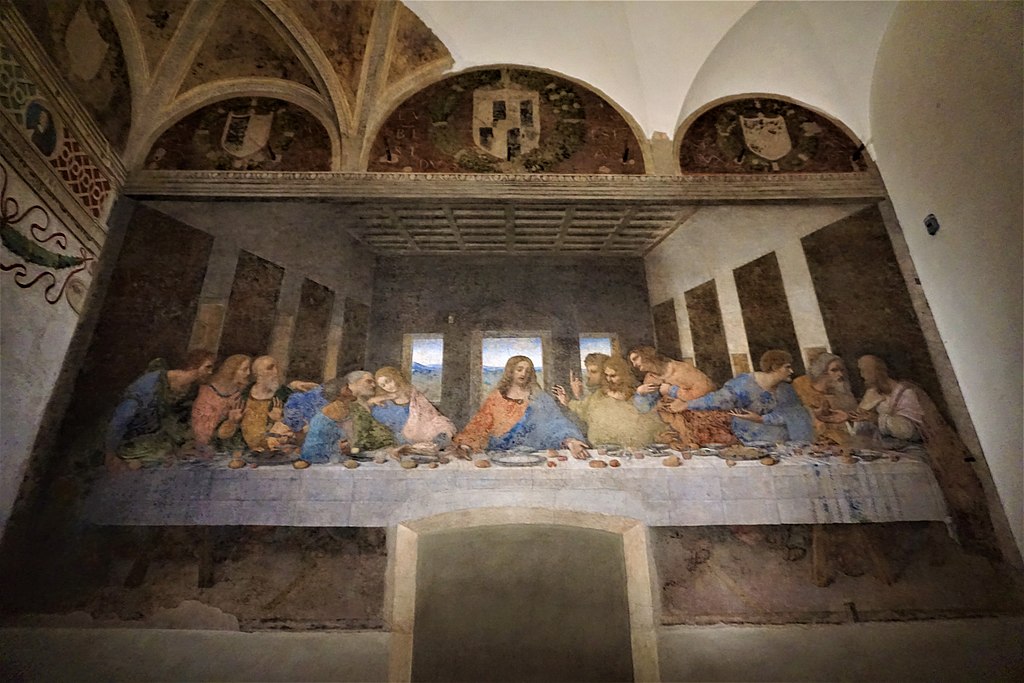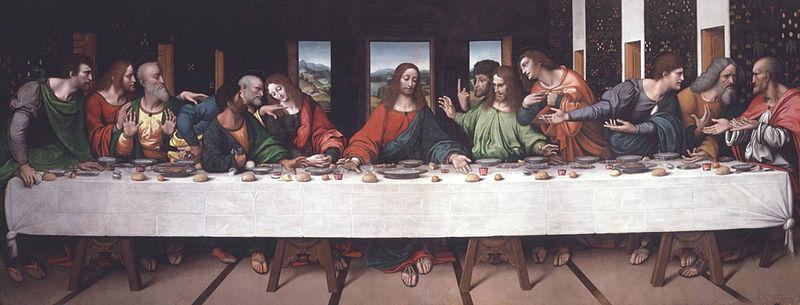Sometime around 1450 the Duke of Milan, Francesco I Sforza, ordered the construction of a Dominican convent and church at the site of a prior chapel dedicated to the Marian devotion of St Mary of the Graces. Construction of the church took several decades, and when Francesco died in 1466, his son Duke Ludovico Sforza decided to have the church serve as the Sforza family mausoleum. He rebuilt the cloister and the apse, both completed after 1490, and he added a mortuary chapel adjacent to the cloister. The Duke decided to have the walls of the mausoleum decorated with biblical scenes, above which he wanted to have painted the Sforza coat of arms. For this task he employed a 38 year-old artist called Leonardo, who had studied in the studio of the renowned Italian painter Andrea del Verrocchio and was gaining a reputation as an artist. Leonardo’s origins were not auspicious. He was born out of wedlock to a notary, Piero da Vinci, and a peasant woman, Caterina. They both lived in the Tuscan town of Vinci, in the region of Florence, and Leonardo became known as Leonardo da Vinci.
Leonardo was allowed a free hand in how he depicted his scene, but it seems likely that the Duke chose the subject of the Last Supper. Around 1495 Leonardo began preparing the wall of the mausoleum for painting. He decided to paint in the fresco style with oil and tempera paints. Da Vinci used experimental techniques on the painting. Instead on painting in the buon fresco style (applying pigments to wet plaster), Leonardo used a style known as a secco (painting on dry plaster). Because he painted on the dry plaster, the colours did not blend into the surface as well. This caused the painting to be much more fragile and led to its rapid deterioration.This was compounded by the fact that the other side of the wall was open to the often wet and sometimes freezing weather of Northern Italy, causing condensation and damp.
The opposite wall of the mausoleum was covered by a fresco by Giovanni Donato da Montorfano showing the Crucifixion. Leonardo was asked to add figures of the Sforza family in tempera to the other fresco, and these figures deteriorated as quickly as his Last Supper. The work dragged on over three years, and there were long periods when Leonardo was absent. He was berated by a prior in the monastery who had been complaining to the Duke about the length of time Leonardo was taking over the painting, and an irate Leonardo told the prior that if he didn’t shut up he would paint his face on the figure of Judas.
The deterioration of the painting continued. Sixty years after Leonardo had finished the painting, the figures were unrecognisable, and 150 years later there was little evidence left that there had ever been a fresco painted on the wall, and a doorway was cut through which obliterated Christ’s feet. The greatest Last Supper of all time, painted by the greatest genius of the century was lost forever.

The now restored Last Supper in the Santa Maria delle Grazie
Leonardo de Vinci was tutor to many students who later followed his style. In the list of members of his studio that he kept, Leonardo mentions an artist called Giampietrino. This is a nickname, and scholars have struggled to ascertain the real name of the artist. It’s important because it was Giampietrino who helped Leonardo paint the Last Supper in the Santa Maria delle Grazie.
When Leonardo’s patron, Ludovico Sforza, the Duke of Milan, was deposed by the French in 1500, Leonardo fled to Venice where he was employed as a military architect and engineer. He spent the next six years in a number of roles, but he was given several important artistic commissions, one of which was a portrait of Lisa del Giocondo. In 1506 he was summoned back to Milan by the acting French governor of the city, Charles II d'Amboise. Upon his return, he took on another young pupil, Count Francesco Melzi, the son of a Lombard aristocrat, who later on became Leonardo’s secretary and lifelong friend.
During his earlier travels, Leonardo had been accompanied by a young man whom he had taken under his wing at the age of 10 as a garzone (studio boy) in the workshop. Now known only as Salaì, (little devil) he was the son of Pietro di Giovanni, a tenant of Leonardo’s vineyard near the Porta Vercellina, Milan. Leonardo sometimes used him as a model for his paintings, but he was an unruly boy and Leonardo described him as, “A liar, a thief, stubborn and a glutton.” after he had made off with money and valuables on at least five occasions and spent a fortune on clothes. Nevertheless, Leonardo kept him in his household for more than 25 years, and though he produced several copies of Leonardo’s paintings, (including a nude Mona Lisa) Salaì’s work is considered inferior. Leonardo’s sex life is very obscure, but it’s significant that there were never any women in his life.
By1508, Leonardo was back in Milan, living in his own house in Porta Orientale in the parish of Santa Babila. It was probably during this time that Melzi worked with Leonardo on the unfinished portrait of Lisa del Gioconda. Apart from all his other achievements, Leonardo will be remembered primarily for the Last Supper and the Mona Lisa, which was copied whilst Leonardo was alive, and probably with his guidance and approval. There are two paintings of the Gioconda in existence. The first is hanging in the Louvre, and is attributed to Leonardo. The other is in the Museo del Prado, Madrid and only came to be recognised for what it was when restorers began cleaning it. Exhaustive tests revealed that the second was painted at the same time as the first, and the most likely second artist was Melzi, Leonardo’s favourite student. However, nobody had yet copied the Last Supper.
During his second stay in Milan, it seems almost inconceivable that Leonardo did not return to Santa Maria delle Grazie and inspect his Last Supper painted 13 years earlier. He would have seen the paint and plaster peeling and realised that his masterpiece was doomed. It’s hard to say how he felt, but he was busy with so many things in his life that he probably had no time to do anything about it. Giampietrino, the student who had helped him paint it, was still living in Milan, and was a famous artist in his own right with a multitude of commissions from prominent figures of the aristocracy. But they were both together in Milan for around 7 years. Another of his old students was doing quite well, too. Andrea Solari followed Leonardo’s style, and was also working on a sizable number of commissions. Both of these artists frequently copied Leonardo’s paintings.
Then fate stepped in, and during October 1515, King Francis I of France recaptured Milan and a year later, Leonardo entered Francis’ service, being given the use of the manor house Clos Lucé near the king’s residence of the royal Château d’Amboise in the Loire valley. He was given a pension of 10,000 scudi, and he was accompanied by Salaì and Melzi who also received pensions. It was during this time that Leonardo suffered a stroke that paralysed his right arm and stopped him from painting. More than one chronicler proposes that this is why he never finished the Mona Lisa. Leonardo died at Clos Lucé on 2 May 1519 at the age of 67.
Meanwhile, in Milan around 1520, Giampietrino began painting an exact size-for-size copy of Leonardo’s Last Supper in the Santa Maria delle Grazie, but this time in oils on canvas. At virtually the same time, Andrea Solari, began another full-size copy of the Last Supper in oils.
To my mind, there are two ways to look at this. Both Giampietrino and Solari waited for Leonardo to die before copying his Last Supper, knowing that the original would soon be obliterated and they could vie to claim credit for the work. Or, during the time that Leonardo lived in Milan, he collaborated with his old pupils and helped them copy it so that it would not be lost. Giampietrino and Solari were already famous artists; they did not need to claim the Last Supper as their own. I would like to think that they copied it to preserve their old master’s masterpiece for posterity.
One thing is for certain, were it not for these copies, Leonardo’s Last Supper would have faded on the wall and been forgotten. If ever there was a good reason to copy another’s work this surely qualifies.
Over the centuries, the Last Supper in the Santa Maria delle Grazie has had six attempts at restoration, and one failed attempt to remove it in its entirety to a safer place. It was vandalized by French troops, bombed by the allies during the Second World War, (Which I suppose can also be classed as vandalism.) and finally restored in 1999 to the painting we see today. That it survived at all in its present form is a tribute to all those people over the centuries who tried to restore, protect and preserve it, but without the two copies, nobody would have known what the original looked like.

The cut-down Last Supper painted by Giampietrino
Giampietrino (Scholars of the art world now believe that Giovanni Pietro Rizzoli was the real name of Giampietrino.) went on to promote Leonardo’s style, and produced over 70 paintings which are hung in 47 museums or private collections around the world. The copy of the Last Supper that he painted now hangs in the Magdalen College, Oxford, and is part of the collection of The Royal Academy of Arts. Sometime after the copy had been made, the top third and the ends were sliced off of Giampietrino’s painting. Solari’s painting is still full-size, and is hanging in Tongerlo Abbey in Westerlo, near Antwerp.
_-_WGA12732 Salzi.jpg)
The full size Last Supper painted by Solari
Over the centuries, Leonardo’s The Last Supper has become the most copied painting of all time, but Leonardo was not the originator of the idea of a Last Supper, nor is he the only one to exploit a theme that had many uses.